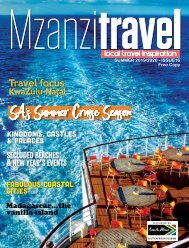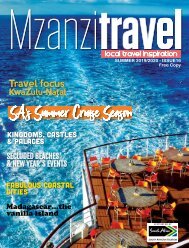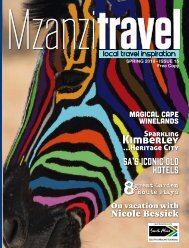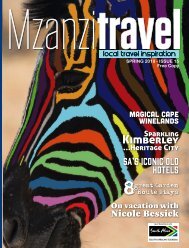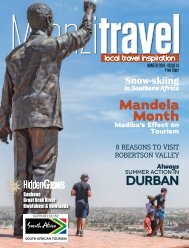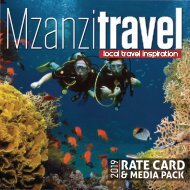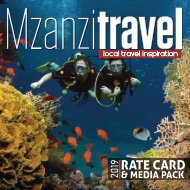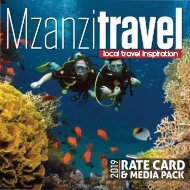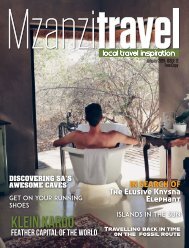Create successful ePaper yourself
Turn your PDF publications into a flip-book with our unique Google optimized e-Paper software.
Cultural Travel<br />
South Africa’s daily news headlines are enough to<br />
make anyone feel depressed. But they hide an<br />
essential truth about this country and its people:<br />
despite so much bad news, South Africans<br />
are really a jolly, fun-loving nation in a country<br />
blessed with a colourful and diverse abundance<br />
of festivals, carnivals and fun celebrations of<br />
every description.<br />
In fact, the country may have more festivals than most comparable<br />
other countries. South Africans seem to need little or no excuse to<br />
let their hair down and party, celebrating everything from olives and<br />
cherries, to the start of the fishing season in Cape Town, the arts,<br />
prickly pears, oysters, witblits, whales, crayfish, science, wildlife, wine,<br />
jazz and even the attempted blowing up of the British parliament in<br />
1605. Do you get the idea?<br />
Cape Town’s famous minstrel carnival where marching troupes, dancers and musicians take<br />
over the streets every January 2 / urbancowboy - Shutterstock.com<br />
And as a tourist attraction they draw fun-loving people from all over<br />
the world.<br />
Cape Town Minstrel Carnival<br />
Probably the oldest festival or carnival, and one of the most popular,<br />
that still takes place each year with a colourful explosion of marching<br />
bands and choirs, troops of marchers and dancers, and colourful<br />
costumes and makeup through the city streets, is Cape Town’s<br />
Minstrel Carnival. It is also known variously as the Coon Carnival (used<br />
not in a derogatory sense, although these days the term ‘minstrel’ is<br />
preferred) and, in Afrikaans, the Kaapse Klopse (the more original or<br />
traditional name). This joyous celebration – with troops competing<br />
fiercely for top honours – starts with a night-time street parade on<br />
New Year’s Eve, followed by a mass event at Green Point Stadium on<br />
Tweede Nuwejaar (second New Year, or 2nd January).<br />
The carnival is said to have originated with slaves being given time off<br />
by their masters to celebrate New Year on the 2nd January each year.<br />
It later gained further momentum when former slaves celebrated the<br />
official end of slavery in December 1834 with street parades, bonfires<br />
and fireworks. Its further development was influenced by American<br />
minstrels who regularly visited the Cape, hence the similarity in<br />
costumes and makeup.<br />
Today locals, joined by visitors from all over the world, can join in<br />
the celebration with their beloved minstrels each year in what has<br />
become a multi-million rand extravaganza, and a truly original Cape<br />
Town event as much part of the Mother City as Table Mountain.<br />
There are far too many organised festivities in South Africa to list<br />
them all here. But the list that follows will give our readers some idea<br />
of all the fun they can choose from during the year, each year.<br />
58 |ISSUE 4|www.mzanzitravel.co.za | MZANZI TRAVEL



